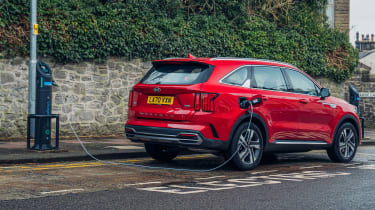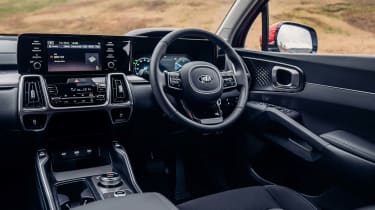Kia Sorento PHEV review
The Kia Sorento plug-in hybrid will make most sense to company-car drivers; private buyers will need to run almost exclusively on electricity to recoup the extra costs
Pros
- Good to drive
- Very practical
- Low company-car tax
Cons
- Expensive to buy outright
- Hesitant hybrid system
- Firm ride
| Car type | Electric range | Fuel economy | CO2 emissions |
|---|---|---|---|
| Plug-in hybrid | 35 miles | 177mpg | 38g/km |
We were impressed with the latest Kia Sorento when it launched in 2020. It was available only as a diesel or hybrid initially, but a plug-in version has now joined the ranks – aimed squarely at company-car drivers searching for a cheap-to-run family SUV.
From the outset, it looks like a compelling package: a 35-mile electric range, low Benefit-in-Kind tax of just 12% and a kit list that premium rivals can only dream of. Prices are high, however, making it harder to justify for private buyers looking to limit their carbon footprint.
Featuring a 13.8kWh battery and a 1.6-litre turbocharged petrol engine, the new Sorento plug-in hybrid produces a significant 261bhp. It’ll do 0-60mph in 8.4 seconds; three-tenths of a second faster than the standard hybrid.
Achieving that electric range is fairly straightforward. Kia provides cables for public and home charging, claiming a top-up time of three hours and 25 minutes from a 3kW wallbox, or just over five hours from a three-pin domestic plug. In reality, we got around 27 miles of electric running over a mixed test route, although solely urban driving might see an improvement to nearer the official figures.
You’ll want to plug the Sorento in as often as possible, not only to minimise trips to the fuel station, but also because the PHEV is at its best gliding silently on electricity. Here, the big SUV is sprightly, hushed and remarkably relaxing to drive.
It's rather frustrating, then, that the Sorento regularly switches its petrol motor on while sitting in stationary traffic – presumably to top up the car’s traditional 12-volt battery and prevent it going flat. This is more noticeable than when you’re moving, as there’s no wind or road noise to distract from the intrusive hum; many conventional petrol-engined cars can sit with their engines off for longer.
Furthermore, if you allow the hybrid batteries to run down, you’ll find the Sorento struggles to juggle its two power sources particularly effectively. The car can become confused at times – especially when putting your foot down at a junction or when asking for power on the entry to a roundabout.
It’s a shame, because like its standard hybrid sibling, the Sorento PHEV is surprisingly sharp to drive. Body control is excellent for something so big and heavy, and lean is well controlled through faster changes of direction. The steering has a good weight to it, even if it doesn’t offer the same level of feedback available in some rivals.
The trade-off for that lack of roll through the bends is a slightly firm ride. Yet, even on the standard-fit 19-inch wheels there’s a composure to the way the Sorento handles; the big SUV remains unruffled even when you hit a big crack or pothole in the road. Elsewhere, quality remains a Sorento strong point.
In July 2022, Kia streamlined the Sorento range to a single 'Edition' trim level, replacing the previous 2, 3 and 4 grades in the process. This specification includes black exterior styling, 19-inch alloys, a panoramic sunroof, a head-up display, a powered tailgate, remote parking assistance, a 360-degree camera, a premium 12-speaker stereo, wireless phone charging and 10-way (driver) plus eight-way (passenger) power-adjustable front seats.

The switch to plug-in hybrid power has done little to dent the Sorento’s appeal as a practical family hauler. It sacrifices just four litres of boot space (now 604 litres) versus the normal hybrid, with a van-like 1,988 litres with all five rear seats folded flat.
Many premium hybrid SUV rivals are only available with five seats, whereas the Kia not only has room for seven; it also boasts an almost completely flat floor in the middle row, plus features like air-conditioning controls for the rearmost occupants. Frustratingly, there's no under floor storage, forcing you to leave the charging cables at home, or store them alongside your luggage.





